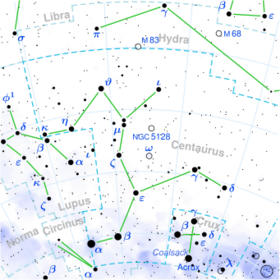Astronomy:Xi1 Centauri
| Observation data Equinox J2000.0]] (ICRS) | |
|---|---|
| Constellation | Centaurus |
| Right ascension | 13h 03m 33.30528s[1] |
| Declination | −49° 31′ 38.1518″[1] |
| Apparent magnitude (V) | +4.83[2] |
| Characteristics | |
| Spectral type | A0 V[3] |
| U−B color index | +0.014[2] |
| B−V color index | +0.030[2] |
| Astrometry | |
| Radial velocity (Rv) | 0.00±3.70[4] km/s |
| Proper motion (μ) | RA: −47.55[1] mas/yr Dec.: −11.52[1] mas/yr |
| Parallax (π) | 14.79 ± 0.27[1] mas |
| Distance | 221 ± 4 ly (68 ± 1 pc) |
| Absolute magnitude (MV) | +0.68[5] |
| Details[6] | |
| Mass | 2.39 M☉ |
| Radius | 2.7[7] R☉ |
| Luminosity | 43.2[8] L☉ |
| Surface gravity (log g) | 4.11±0.14 cgs |
| Temperature | 10,462±356 K |
| Rotational velocity (v sin i) | 185[9] km/s |
| Age | 125 Myr |
| Other designations | |
| Database references | |
| SIMBAD | data |
Xi1 Centauri, Latinized from ξ1 Centauri, is a solitary[11] star in the southern constellation of Centaurus. It is visible to the naked eye with an apparent visual magnitude of +4.83.[2] With an annual parallax shift of 14.79 mas,[1] it is located around 221 light years from the Sun. At that distance, the apparent visual magnitude of the star is diminished by an interstellar extinction factor of 0.10[12] due to intervening dust. Just 17 arc minutes to the east of Xi1 Centauri lies the galaxy NGC 4945.[13]
This is an A-type main sequence star with a stellar classification of A0 V.[3] It is about 125[6] million years old with a relatively high rate of spin, having a projected rotational velocity of 185 km/s.[9] The star has an estimated 2.4[6] times the mass of the Sun and about 2.7[7] times the Sun's radius. It is radiating 43[8] times the solar luminosity from its outer atmosphere at an effective temperature of 10,462 K.[6]
References
- ↑ 1.0 1.1 1.2 1.3 1.4 1.5 van Leeuwen, F. (2007), "Validation of the new Hipparcos reduction", Astronomy and Astrophysics 474 (2): 653–664, doi:10.1051/0004-6361:20078357, Bibcode: 2007A&A...474..653V.
- ↑ 2.0 2.1 2.2 2.3 Gutierrez-Moreno, Adelina; Moreno, Hugo (June 1968), "A photometric investigation of the Scorpio-Centaurus association", Astrophysical Journal Supplement 15: 459, doi:10.1086/190168, Bibcode: 1968ApJS...15..459G.
- ↑ 3.0 3.1 Bauwens, E. K. J. et al. (2010), "Candidate Calibrators for the In-Orbit Spectrophotometric Calibration of the MIRI Medium Resolution Spectrograph Onboard the James Webb Space Telescope", in Deustua, Susana; Oliveira, Cristina, The 2010 STScI Calibration Workshop, Space Telescope Science Institute, http://www.stsci.edu/~INS/2010CalWorkshop/bauwens.pdf, retrieved 2016-01-10.
- ↑ de Bruijne, J. H. J.; Eilers, A.-C. (October 2012), "Radial velocities for the HIPPARCOS-Gaia Hundred-Thousand-Proper-Motion project", Astronomy & Astrophysics 546: 14, doi:10.1051/0004-6361/201219219, A61, Bibcode: 2012A&A...546A..61D.
- ↑ Anderson, E.; Francis, Ch. (2012), "XHIP: An extended hipparcos compilation", Astronomy Letters 38 (5): 331, doi:10.1134/S1063773712050015, Bibcode: 2012AstL...38..331A.
- ↑ 6.0 6.1 6.2 6.3 David, Trevor J.; Hillenbrand, Lynne A. (2015), "The Ages of Early-Type Stars: Strömgren Photometric Methods Calibrated, Validated, Tested, and Applied to Hosts and Prospective Hosts of Directly Imaged Exoplanets", The Astrophysical Journal 804 (2): 146, doi:10.1088/0004-637X/804/2/146, Bibcode: 2015ApJ...804..146D.
- ↑ 7.0 7.1 Pasinetti Fracassini, L. E. et al. (February 2001), "Catalogue of Apparent Diameters and Absolute Radii of Stars (CADARS)", Astronomy and Astrophysics 367: 521–524, doi:10.1051/0004-6361:20000451, Bibcode: 2001A&A...367..521P.
- ↑ 8.0 8.1 McDonald, I. et al. (2012), "Fundamental Parameters and Infrared Excesses of Hipparcos Stars", Monthly Notices of the Royal Astronomical Society 427 (1): 343–57, doi:10.1111/j.1365-2966.2012.21873.x, Bibcode: 2012MNRAS.427..343M.
- ↑ 9.0 9.1 Uesugi, Akira; Fukuda, Ichiro (1970), "Catalogue of rotational velocities of the stars", Contributions from the Institute of Astrophysics and Kwasan Observatory (University of Kyoto), Bibcode: 1970crvs.book.....U.
- ↑ "ksi01 Cen". SIMBAD. Centre de données astronomiques de Strasbourg. http://simbad.u-strasbg.fr/simbad/sim-basic?Ident=ksi01+Cen.
- ↑ Eggleton, P. P.; Tokovinin, A. A. (September 2008), "A catalogue of multiplicity among bright stellar systems", Monthly Notices of the Royal Astronomical Society 389 (2): 869–879, doi:10.1111/j.1365-2966.2008.13596.x, Bibcode: 2008MNRAS.389..869E.
- ↑ Gontcharov, G. A. (November 2012), "Spatial distribution and kinematics of OB stars", Astronomy Letters 38 (11): 694–706, doi:10.1134/S1063773712110035, Bibcode: 2012AstL...38..694G.
- ↑ O'Meara, Stephen James (2016), Deep-Sky Companions: The Caldwell Objects (2nd ed.), Cambridge University Press, p. 392, ISBN 978-1316033531, https://books.google.com/books?id=evkODQAAQBAJ&pg=PA392.
 |



